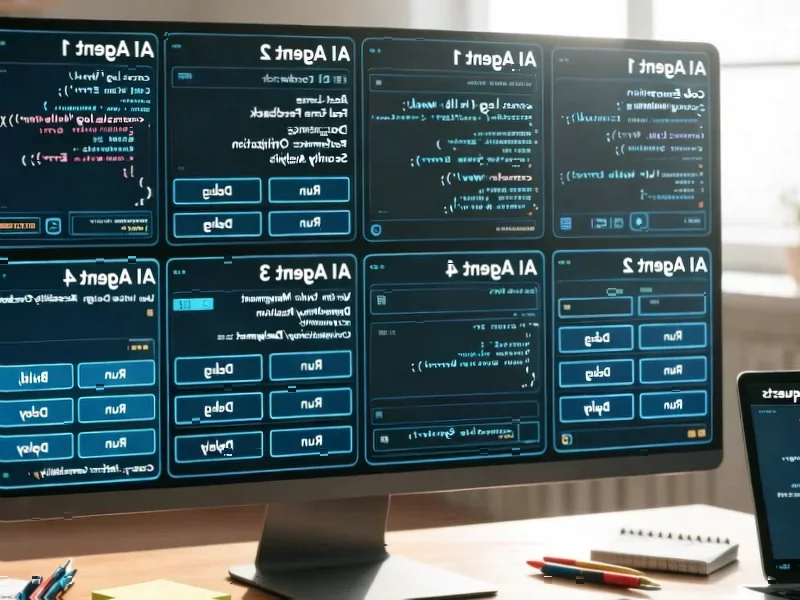According to PYMNTS.com, research reveals that coding agents can efficiently generate code in controlled environments but suffer significant reasoning deterioration when human guidance is removed. The study found that teams implementing consistent review points and role definitions achieved up to 31% higher accuracy than those allowing agents to operate independently. Walmart is creating new “agent developer” roles where engineers train, supervise, and integrate coding agents into production workflows rather than replacing human developers entirely. The findings align with earlier research on CoAct-1: Computer-Using Agents with Coding as Actions, which similarly concluded that human interaction remains essential for reliable outcomes. This emerging reality suggests the future of software development lies in structured collaboration rather than full automation.
The Human Context Gap That AI Can’t Bridge
What the research reveals is a fundamental limitation in current AI systems: they lack the contextual understanding that human developers accumulate through experience. While AI can generate syntactically correct code efficiently, it struggles with the nuanced judgment required for production-ready software. Human developers understand business constraints, user experience implications, and organizational priorities that rarely appear in code comments or specifications. This “invisible context” separates functional code from effective software solutions. The deterioration in reasoning when human guidance is removed suggests AI systems are essentially operating without the institutional knowledge that human developers naturally incorporate.
Enterprise Strategy: Augmentation Over Automation
Walmart’s approach of creating “agent developer” roles represents a strategic shift that other enterprises are likely to follow. Rather than viewing AI as a cost-cutting replacement for human labor, forward-thinking organizations are treating it as a force multiplier. This reflects a broader pattern in enterprise technology adoption where the most successful implementations blend human expertise with machine efficiency. The 31% accuracy improvement with structured review points demonstrates that the real value emerges from the interaction between human judgment and AI execution. Companies that try to fully automate development will likely face technical debt, security vulnerabilities, and maintenance challenges that outweigh any short-term cost savings.
Small Business Development Revolution
For small businesses and entrepreneurs, vibe coding represents an accessibility breakthrough rather than an automation threat. The ability to prototype applications with natural language prompts lowers the barrier to software development significantly. However, the research suggests successful small business implementations will still require either technical oversight or partnerships with developers who can provide the necessary validation and refinement. The real opportunity lies in reducing development costs while maintaining quality through strategic human involvement at critical stages. This could enable more small businesses to build custom software solutions that were previously financially out of reach.
The Hidden Security and Compliance Risks
Unmonitored AI coding introduces systemic risks that extend beyond simple functionality issues. As the Stanford “Takedown” paper highlights, autonomous AI can introduce security vulnerabilities at scale that might go undetected until exploited. Compliance requirements in regulated industries like finance and healthcare demand understanding not just what the code does, but why it does it—a level of reasoning current AI systems struggle with. Human oversight becomes essential for maintaining audit trails, ensuring regulatory compliance, and implementing security best practices that AI might overlook in pursuit of functional solutions.
The Evolving Role of Software Developers
Rather than making developers obsolete, AI coding is transforming their responsibilities from syntax specialists to system conductors. The most valuable developers will be those who can effectively manage, train, and validate AI systems while maintaining the architectural vision and business alignment. This represents a significant upskilling opportunity for developers who embrace these new responsibilities. The research suggests that developers who can structure effective feedback loops and validation checkpoints will become increasingly valuable as organizations scale their AI-assisted development efforts.
Building Effective Human-AI Development Teams
The key to successful implementation lies in designing deliberate collaboration frameworks rather than hoping for organic cooperation. Organizations need to establish clear review points, validation protocols, and role definitions that leverage both human judgment and AI efficiency. The 31% accuracy improvement with structured approaches indicates that ad-hoc collaboration can actually slow development rather than accelerate it. Companies should invest in training developers on AI supervision techniques and creating workflows that embed human reasoning at critical decision points while allowing AI to handle repetitive coding tasks.




